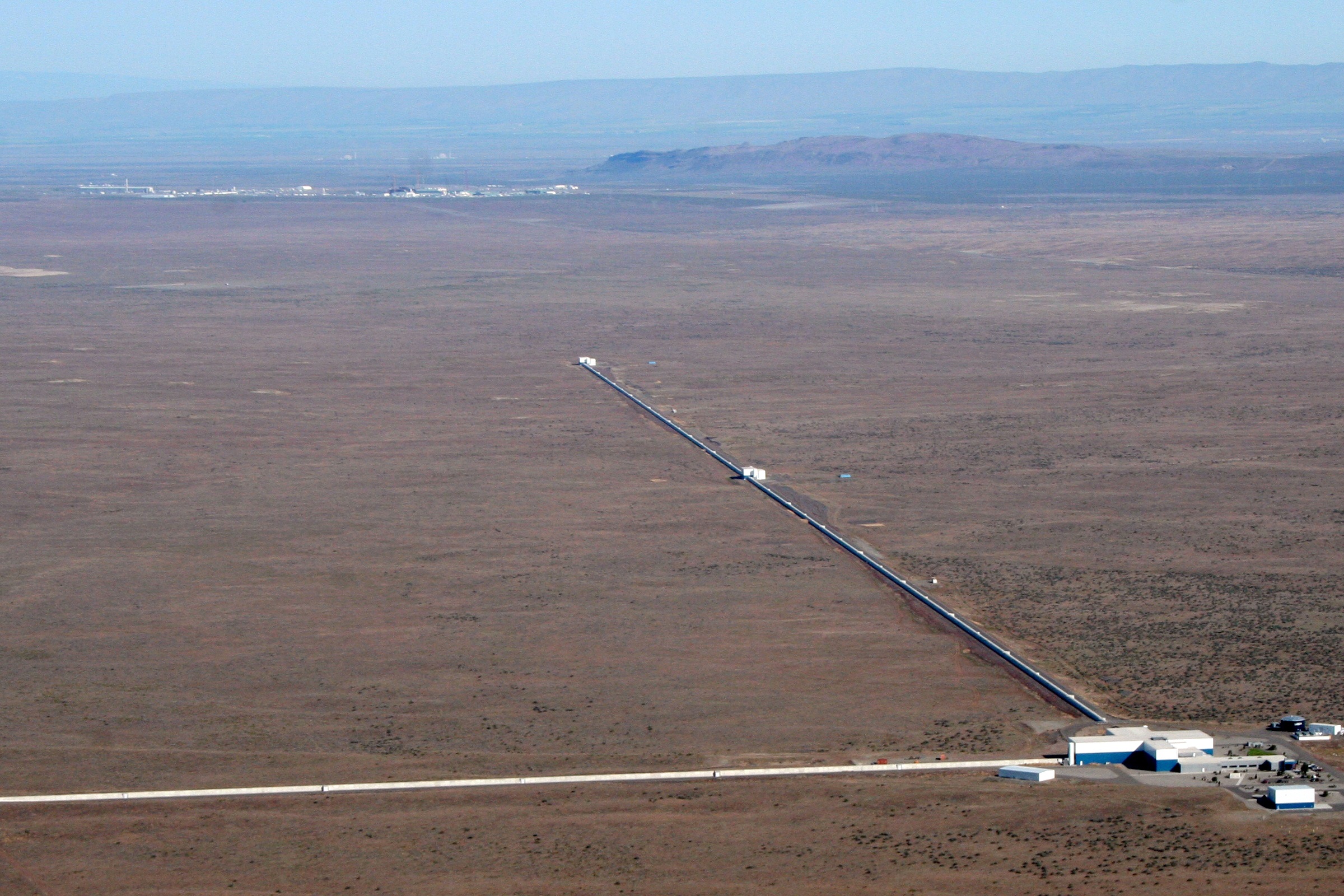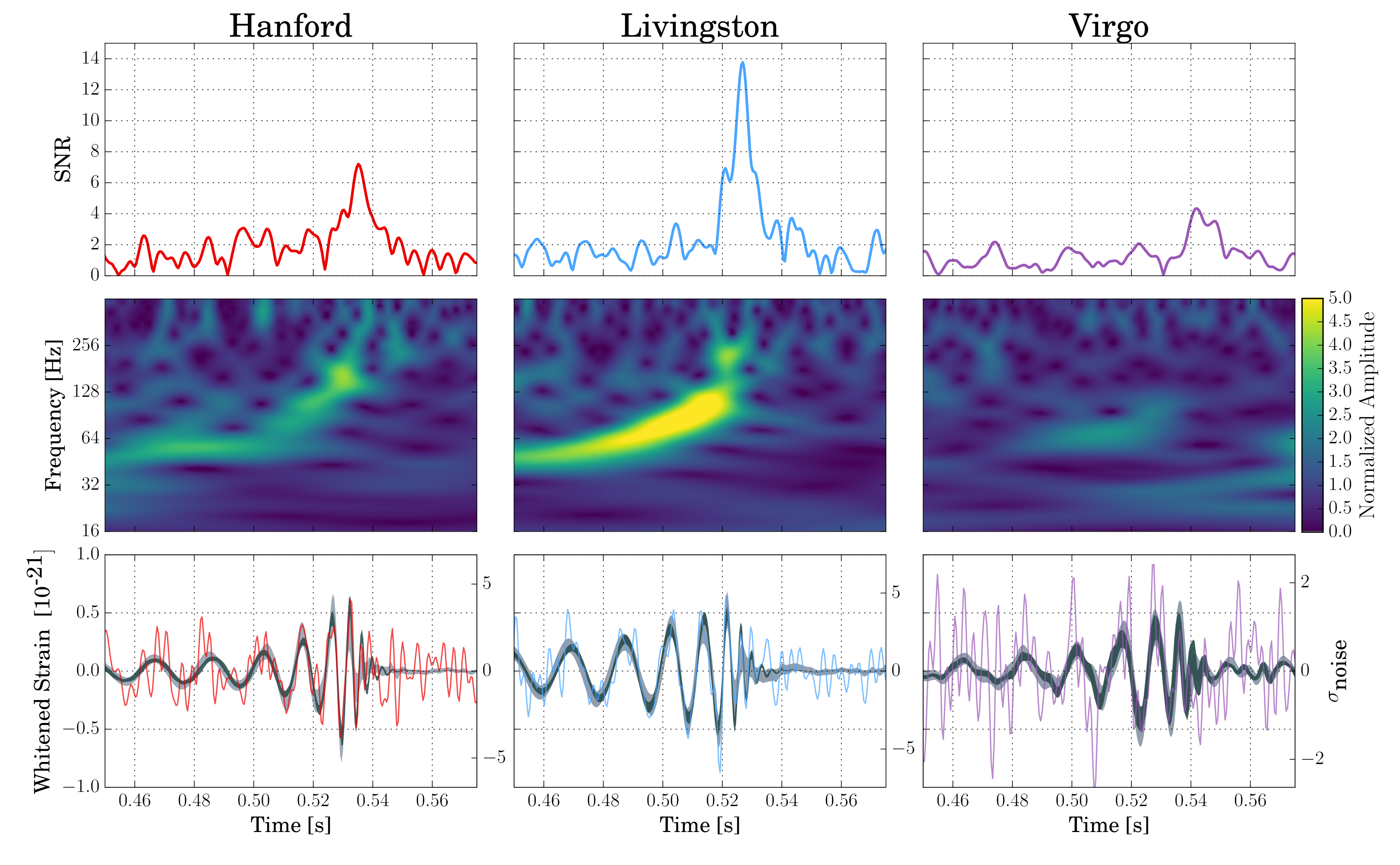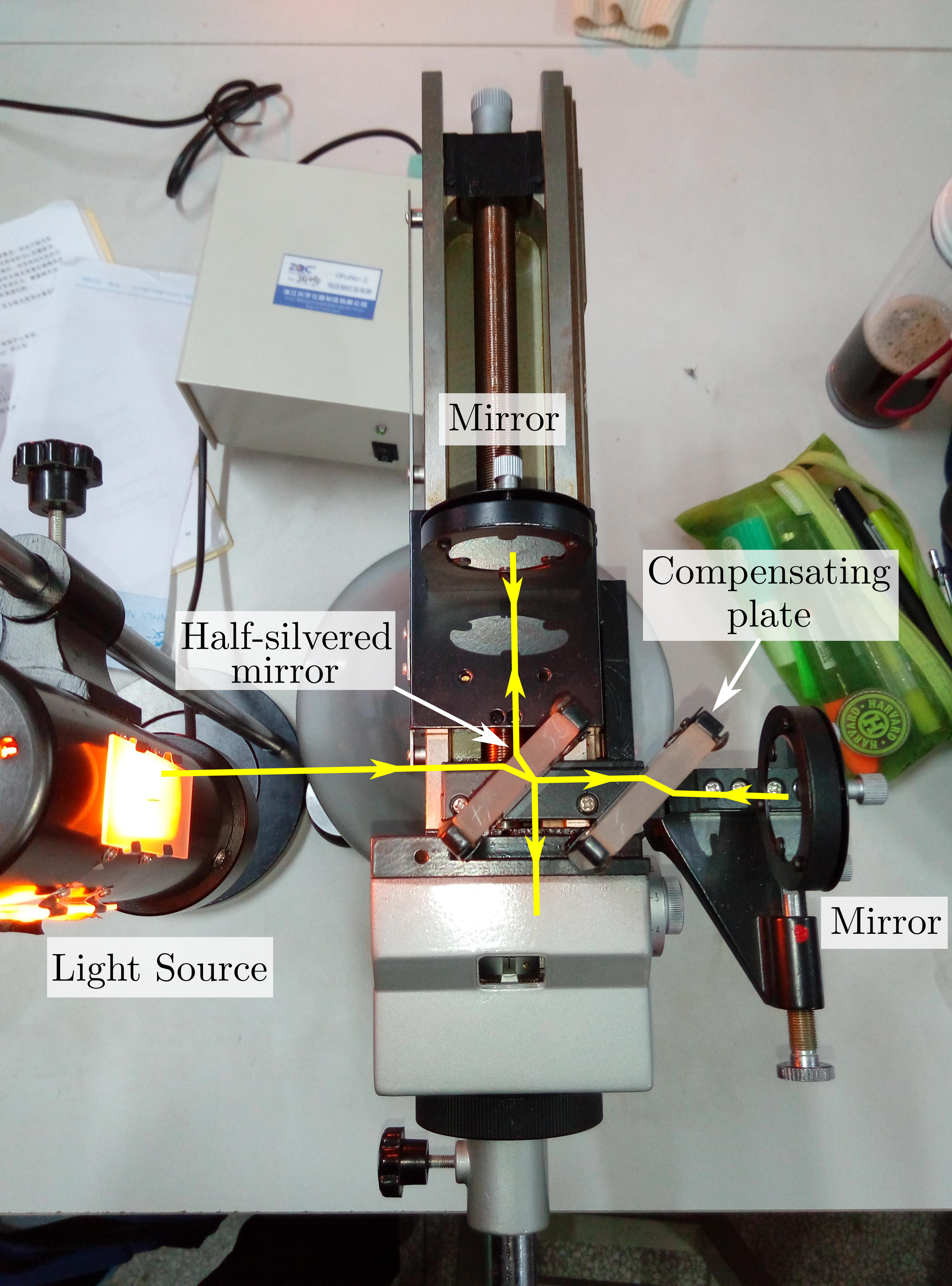|
KAGRA
The Kamioka Gravitational Wave Detector (KAGRA), is a large interferometer designed to detect gravitational waves predicted by the general theory of relativity. KAGRA is a Michelson interferometer that is isolated from external disturbances: its mirrors and instrumentation are suspended and its laser beam operates in a vacuum. The instrument's two arms are three kilometres long and located underground at the Kamioka Observatory which is near the Kamioka section of the city of Hida in Gifu Prefecture, Japan. KAGRA is a project of the gravitational wave studies group at the Institute for Cosmic Ray Research (ICRR) of the University of Tokyo. It became operational on 25 February 2020, when it began data collection. It is Asia's first gravitational wave observatory, the first in the world built underground, and the first whose detector uses cryogenic mirrors. It is expected to have an operational sensitivity equal to, or greater than, LIGO and Virgo. The Kamioka Observatory special ... [...More Info...] [...Related Items...] OR: [Wikipedia] [Google] [Baidu] |
Gravitational Wave Detector
A gravitational-wave detector (used in a gravitational-wave observatory) is any device designed to measure tiny distortions of spacetime called gravitational waves. Since the 1960s, various kinds of gravitational-wave detectors have been built and constantly improved. The present-day generation of laser interferometers has reached the necessary sensitivity to detect gravitational waves from astronomical sources, thus forming the primary tool of gravitational-wave astronomy. The first direct detection of gravitational waves made in 2015 by the Advanced LIGO observatories, a feat which was awarded the 2017 Nobel Prize in Physics. Challenge The direct detection of gravitational waves is complicated by the extraordinarily small effect the waves produce on a detector. The amplitude of a spherical wave falls off as the inverse of the distance from the source. Thus, even waves from extreme systems such as merging binary black holes die out to a very small amplitude by the time they ... [...More Info...] [...Related Items...] OR: [Wikipedia] [Google] [Baidu] |
Gravitational Radiation
Gravitational waves are waves of the intensity of gravity generated by the accelerated masses of an orbital binary system that propagate as waves outward from their source at the speed of light. They were first proposed by Oliver Heaviside in 1893 and then later by Henri Poincaré in 1905 as waves similar to electromagnetic waves but the gravitational equivalent. Gravitational waves were later predicted in 1916 by Albert Einstein on the basis of his general theory of relativity as ripples in spacetime. Later he refused to accept gravitational waves. Gravitational waves transport energy as gravitational radiation, a form of radiant energy similar to electromagnetic radiation. Newton's law of universal gravitation, part of classical mechanics, does not provide for their existence, since that law is predicated on the assumption that physical interactions propagate instantaneously (at infinite speed)showing one of the ways the methods of Newtonian physics are unable to explain p ... [...More Info...] [...Related Items...] OR: [Wikipedia] [Google] [Baidu] |
Takaaki Kajita
is a Japanese physicist, known for neutrino experiments at the Kamioka Observatory – Kamiokande and its successor, Super-Kamiokande. In 2015, he was awarded the Nobel Prize in Physics jointly with Canadian physicist Arthur B. McDonald. On 1 October 2020, he became the president of the Science Council of Japan. Early life and education Kajita was born in 1959 in Higashimatsuyama, Saitama, Japan. He liked studying thought rather than memorizing, especially with interest in physics, biology, world history, Japanese history, and earth science in high school. He studied physics at Saitama University and graduated in 1981. He received his doctorate in 1986 at the University of Tokyo. At the University of Tokyo, he joined Masatoshi Koshiba's research group because neutrinos "seemed like they might be interesting." Career and research Since 1988, Kajita has been at the Institute for Cosmic Radiation Research, University of Tokyo, where he became an assistant professor in 1992 a ... [...More Info...] [...Related Items...] OR: [Wikipedia] [Google] [Baidu] |
Gravitational Wave
Gravitational waves are waves of the intensity of gravity generated by the accelerated masses of an orbital binary system that propagate as waves outward from their source at the speed of light. They were first proposed by Oliver Heaviside in 1893 and then later by Henri Poincaré in 1905 as waves similar to electromagnetic waves but the gravitational equivalent. Gravitational waves were later predicted in 1916 by Albert Einstein on the basis of his general theory of relativity as ripples in spacetime. Later he refused to accept gravitational waves. Gravitational waves transport energy as gravitational radiation, a form of radiant energy similar to electromagnetic radiation. Newton's law of universal gravitation, part of classical mechanics, does not provide for their existence, since that law is predicated on the assumption that physical interactions propagate instantaneously (at infinite speed)showing one of the ways the methods of Newtonian physics are unable to explain p ... [...More Info...] [...Related Items...] OR: [Wikipedia] [Google] [Baidu] |
Kamioka Observatory
The is a neutrino and gravitational waves laboratory located underground in the Mozumi mine of the Kamioka Mining and Smelting Co. near the Kamioka section of the city of Hida in Gifu Prefecture, Japan. A set of groundbreaking neutrino experiments have taken place at the observatory over the past two decades. All of the experiments have been very large and have contributed substantially to the advancement of particle physics, in particular to the study of neutrino astronomy and neutrino oscillation. The mine The Mozumi mine is one of two adjacent mines owned by the Kamioka Mining and Smelting Co. (a subsidiary of the Mitsui Mining and Smelting Co. Mitsui Kinzoku'). The mine is famous as the site of one of the greatest mass-poisonings in Japanese history. From 1910 to 1945, the mine operators released cadmium from the processing plant into the local water. This cadmium caused what the locals called itai-itai disease. The disease caused weakening of the bones and extreme pai ... [...More Info...] [...Related Items...] OR: [Wikipedia] [Google] [Baidu] |
LIGO
The Laser Interferometer Gravitational-Wave Observatory (LIGO) is a large-scale physics experiment and observatory designed to detect cosmic gravitational waves and to develop gravitational-wave observations as an astronomical tool. Two large observatories were built in the United States with the aim of detecting gravitational waves by laser interferometry. These observatories use mirrors spaced four kilometers apart which are capable of detecting a change of less than one ten-thousandth the charge diameter of a proton. (that is, to Proxima Centauri at ). The initial LIGO observatories were funded by the United States National Science Foundation (NSF) and were conceived, built and are operated by Caltech and MIT. They collected data from 2002 to 2010 but no gravitational waves were detected. The Advanced LIGO Project to enhance the original LIGO detectors began in 2008 and continues to be supported by the NSF, with important contributions from the United Kingdom's Science ... [...More Info...] [...Related Items...] OR: [Wikipedia] [Google] [Baidu] |
TAMA300
TAMA 300 is a gravitational wave detector located at the Mitaka campus of the National Astronomical Observatory of Japan. It is a project of the gravitational wave studies group at the Institute for Cosmic Ray Research (ICRR) of the University of Tokyo. The ICRR was established in 1976 for cosmic ray studies, and is currently developing the Kamioka Gravitational Wave Detector (KAGRA). TAMA 300 was preceded in Mitaka by a 20m prototype TAMA 20 in years 1991-1994. Later the prototype was moved underground to Kamioka mine and renamed LISM. It operated 2000-2002 and established seismic quietness of the underground location. Construction of the TAMA project started in 1995. Data were collected from 1999 to 2004. It adopted a Fabry–Pérot Michelson interferometer (FPMI) with power recycling. It is officially known as the 300m Laser Interferometer Gravitational Wave Antenna due to having 300 meter long (optical) arms. The goal of the project was to develop advanced techniques nee ... [...More Info...] [...Related Items...] OR: [Wikipedia] [Google] [Baidu] |
Institute For Cosmic Ray Research
The Institute for Cosmic Ray Research (ICRR) of the University of Tokyo (東京大学宇宙線研究所 ''Tōkyōdaigaku Uchūsen Kenkyūsho'') was established in 1976 for the study of cosmic rays. The gravitational wave studies group is currently constructing the detector KAGRA located at the Kamioka Observatory. Facilities * Kashiwa Campus at the University of Tokyo * Akeno Observatory * Kamioka Observatory * Norikura Observatory Current projects *Super-Kamiokande - Detection of neutrinos and search for proton decays in a large water tank *Tibet - Search for point sources of VHE cosmic gamma rays at Tibet heights *Telescope Array Project - Aiming at highest energy cosmic ray physics by detecting weak light from atmosphere"New Ground-Based Arrays to Probe Cosmic Powerhouses" By Dennis Normile Science 30 April 1999: 734-735 *Gravitational Wave Group - Constructing the gravitational wave detector KAGRA The Kamioka Gravitational Wave Detector (KAGRA), is a large interferometer ... [...More Info...] [...Related Items...] OR: [Wikipedia] [Google] [Baidu] |
TAMA 300
TAMA 300 is a gravitational wave detector located at the Mitaka campus of the National Astronomical Observatory of Japan. It is a project of the gravitational wave studies group at the Institute for Cosmic Ray Research (ICRR) of the University of Tokyo. The ICRR was established in 1976 for cosmic ray studies, and is currently developing the Kamioka Gravitational Wave Detector (KAGRA). TAMA 300 was preceded in Mitaka by a 20m prototype TAMA 20 in years 1991-1994. Later the prototype was moved underground to Kamioka mine and renamed LISM. It operated 2000-2002 and established seismic quietness of the underground location. Construction of the TAMA project started in 1995. Data were collected from 1999 to 2004. It adopted a Fabry–Pérot Michelson interferometer (FPMI) with power recycling. It is officially known as the 300m Laser Interferometer Gravitational Wave Antenna due to having 300 meter long (optical) arms. The goal of the project was to develop advanced techniques ne ... [...More Info...] [...Related Items...] OR: [Wikipedia] [Google] [Baidu] |
Virgo Interferometer
The Virgo interferometer is a large interferometer designed to detect gravitational waves predicted by the general theory of relativity. Virgo is a Michelson interferometer that is isolated from external disturbances: its mirrors and instrumentation are suspended and its laser beam operates in a vacuum. The instrument's two arms are three kilometres long and located in Santo Stefano a Macerata, near the city of Pisa, Italy. Virgo is hosted by the European Gravitational Observatory (EGO), a consortium founded by the French CNRS and Italian INFN. The ''Virgo Collaboration'' operates the detector and is composed of more than 650 members, representing 119 institutions in 14 different countries. Other interferometers similar to Virgo have the same goal of detecting gravitational waves, including the two LIGO interferometers in the United States (at the Hanford Site and in Livingston, Louisiana). Since 2007, Virgo and LIGO have agreed to share and jointly analyze the data recorded ... [...More Info...] [...Related Items...] OR: [Wikipedia] [Google] [Baidu] |
Michelson Interferometer
The Michelson interferometer is a common configuration for optical interferometry and was invented by the 19/20th-century American physicist Albert Abraham Michelson. Using a beam splitter, a light source is split into two arms. Each of those light beams is reflected back toward the beamsplitter which then combines their amplitudes using the superposition principle. The resulting interference pattern that is not directed back toward the source is typically directed to some type of photoelectric detector or camera. For different applications of the interferometer, the two light paths can be with different lengths or incorporate optical elements or even materials under test. The Michelson interferometer (among other interferometer configurations) is employed in many scientific experiments and became well known for its use by Michelson and Edward Morley in the famous Michelson–Morley experiment (1887) in a configuration which would have detected the Earth's motion through the ... [...More Info...] [...Related Items...] OR: [Wikipedia] [Google] [Baidu] |
Gifu Prefecture
is a prefecture of Japan located in the Chūbu region of Honshu. Gifu Prefecture has a population of 1,991,390 () and has a geographic area of . Gifu Prefecture borders Toyama Prefecture to the north; Ishikawa Prefecture to the northwest, Fukui Prefecture and Shiga Prefecture to the west, Mie Prefecture to the southwest, Aichi Prefecture to the south, and Nagano Prefecture to the east. Gifu is the capital and largest city of Gifu Prefecture, with other major cities including Ōgaki, Kakamigahara, and Tajimi. Gifu Prefecture is located in the center of Japan, one of only eight landlocked prefectures, and features the country's center of population. Gifu Prefecture has served as the historic crossroads of Japan with routes connecting the east to the west, including the Nakasendō, one of the Five Routes of the Edo period. Gifu Prefecture was a long-term residence of Oda Nobunaga and Saitō Dōsan, two influential figures of Japanese history in the Sengoku period, sp ... [...More Info...] [...Related Items...] OR: [Wikipedia] [Google] [Baidu] |





